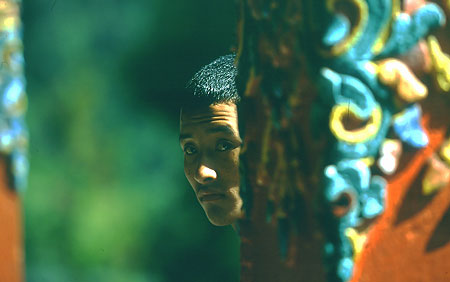Tibet: a ring road around Mount Kailash?
International campaigners for Tibet have voiced their growing concern about a planned ring road around Mount Kailash, Tibet's most sacred mountain.
 International campaigners for Tibet have voiced their growing concern about a planned ring road around Mount Kailash, Tibet's most sacred mountain. News about the possible road was first published by the journalist Kate Saunders, who reported accounts by western travellers and the local population stating that the survey work has already been completed. Construction should begin as early as April 2004, and Tibetans living in the area have been warned not to talk about the possible road. Free Tibet, amongst others, has launched an urgent campaign against the proposed development. Their press statement is published below, as is a link to their site for those wishing to take part in the campaign. "The fragile environment of Mount Kailash, one of the most sacred mountains in the world, may be under threat from Chinese development plans to increase tourism to western Tibet. A 'ring road', which will circumnambulate the mountain, is apparently shortly to be constructed. Western travellers and local people have reported that survey work has been completed, and construction may begin in April 2004. It is not clear whether these plans originate from local prefectural officials in Ngari (Chinese: Ali) or from a higher level. Local Tibetans who live near Kailash have been warned by officials not to speak about the possible road. Mount Kailash is an important place of pilgrimage for followers of many faiths and religions, including Buddhists, Bon practitioners, Jains and Hindus. Most Tibetan pilgrims walk a holy 'kora' or circuit of the mountain (a distance of 56 kilometres which ascends to over 5,700 metres above sea level) in a single day as a way of purging the body of sin. Kailash is also a popular destination for western travellers, who take between three and five days to complete the circuit. Those who complete 108 circuits apparently gain instant enlightenment. China has been actively discouraged from issuing permits for the mountain to be climbed. A Westerner who has been a frequent visitor to the area for more than a decade has said, "Tibetans described this road to me as a 'catastrophe'. They are concerned because Kailash, known to Tibetans as Kang Rinpoche, is such a sacred place and the landscape is so unspoilt." Authorities in the regional capital of Nyari, 155 miles from Kailash, are also planning a civilian airport that would allow tourists fast access from Lhasa. In 2002 more than 850,000 tourists travelled to Tibet, 720,000 of them 'internal' visitors from other parts of China, a 30 per cent increase on 2001. Tibet is currently regarded as 'chic' amongst well-to-do Chinese people. Free Tibet Campaign is working with activists around the world to generate political support for Mount Kailash and nearby sacred Lake Manasarovar to be designated a World Heritage Site on the basis of their spiritual value, and as a means to protect the area from inappropriate development. There are currently 35 cultural landscapes on the World Heritage List inscribed on this basis. They include Uluru-Kata Tjutu National Park (also known as Ayers Rock) in Australia and Tongariro National Park in New Zealand. However, no site can become a World Heritage Site without being nominated by the recognised State Party, in this case China." Photo: Monk in the Hemis monastery - ph Aldo Frezza
| ||||||||
Latest news
Expo / News
Expo / Products
Ocun Diamond S climbing shoes designed for maximum performance, comfort, and precision
A lightweight mountaineering backpack for demanding conditions and terrain.
A versatile high performance three season layering piece perfect for the summer months.
Merino Wool Ski Mountaineering Sock.
Scott skis, light enough for ski touring, and shaped for freeride skiing.
Ever since its market launch, the Barryvox avalanche transceiver has been among the most reliable transceivers in the world.



 Copia link
Copia link
























